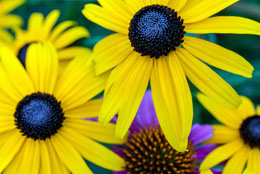Black Eyed Susan plants are amongst the most popular wildflowers seen in home gardens. If you want to learn more about these beautiful plants, the following article will get all the information you need.

If you want big, bold show plants in your garden, then you should think about growing Black Eyed Susan plants. These plants are native to North America, and you can see the wildflowers blooming in the fields and meadows from mid to late summer. These perennial flowering plants are members of the Aster family. They are also known as
Rudbeckia. You will find shades of bright yellow and orange flowers with dark seed head that brighten up your gardens. The flowers come in colors like russet, bronze, and mahogany shades as well. They look like a daisy, and can be single, semi-double, and fully double. To differentiate between the two, you can check the leaves. If you find coarse-textured hairy leaves, then they are Black Eyed Susan plants.
Plant Classification
Kingdom -
Plantae
Sub-kingdom -
Tracheobionta
Superdivision -
Spermatophyta
Division -
Magnoliophyta
Class -
Magnoliopsida
Subclass -
Asteridae
Order -
Asterales
Family -
Asteraceae
Genus -
Rudbeckia L.
Species -
Rudbeckia hirta L.
Common Names - Black Eyed Susan, Brown-eyed Susan, Conedisk, Conedisk Sunflower, Gloriosa Daisy Tall Coneflower.
Planting Instructions
These plants grow 18 inches to 72 inches in height. They bloom from mid to late summer into fall. If you have shorter varieties, then plant them 18 inches apart. The taller varieties need to be planted 44 inches apart.
Black Eyed Susan plants can be propagated through seeds. You can sow the seeds directly into the flower garden soil in spring. You will be able to propagate the plant after two to three years by separation or division. You need to dig up a clump and separate it, or divide it into three or flour smaller clumps. Replant them and water well.
When transplanting the plants, remember that once they bloom in fall, you can divide and transplant them in spring. If you see them bloom in spring, then you should be transplanting these plants in fall. These plants can resist the stress of being relocated. To cause the least amount of stress, transplant the plants during their dormant state in early spring or fall. You should not worry if the flowers do not bloom the first year after transplanting. They will begin to bloom in the coming years.
Growing Instructions
The following instructions will help you grow these plants in your garden.
- You can find seeds in the local nursery. It is very easy to grow and maintain these plants.
- You should sow the seeds indoors for about 6 to 8 weeks before the last frost date. In mid-winter, you can plant the seeds directly in the garden soil in early spring. (You can plant the established seedlings in the garden soil after the last frost date.)
- These plants, like the Thunbergia Alata, are vines. You would, thus, need to provide them with support. You can install trellis or arbor to help them rise skyward as these plants climb by twining.
- You should water the plant with sufficient water. After planting, if you desire, fertilize the soil every 4 to 6 weeks.
- You should pull out the plant after the first frost.
Black Eyed Susan Plant Care
You will not have any problem regarding the care of these plants. They can grow well in average to even poor soil. These plants can tolerate dry soil conditions and do not need to be watered more often. Once they have been established, these plants will flourish without much attention and you will not require a lot of care.
Plant Diseases
These hardy plants are resistant to diseases and insects. Many snails, slugs, and aphids eat the leaves of these plants. The diseases affecting these plants are mostly fungal. You can treat the diseases and insect problems with organic or chemical fungicides and insect repellents.
You can grow these beautiful, bold plants in your garden and create a vibrant atmosphere. These plants are sturdy and long-lasting. You can be sure that they draw other beautiful creatures like bees, butterflies, hummingbirds, etc. to your garden. You can even decorate your vases inside the house with the cuttings of these pretty flowers.






 If you want big, bold show plants in your garden, then you should think about growing Black Eyed Susan plants. These plants are native to North America, and you can see the wildflowers blooming in the fields and meadows from mid to late summer. These perennial flowering plants are members of the Aster family. They are also known as Rudbeckia. You will find shades of bright yellow and orange flowers with dark seed head that brighten up your gardens. The flowers come in colors like russet, bronze, and mahogany shades as well. They look like a daisy, and can be single, semi-double, and fully double. To differentiate between the two, you can check the leaves. If you find coarse-textured hairy leaves, then they are Black Eyed Susan plants.
If you want big, bold show plants in your garden, then you should think about growing Black Eyed Susan plants. These plants are native to North America, and you can see the wildflowers blooming in the fields and meadows from mid to late summer. These perennial flowering plants are members of the Aster family. They are also known as Rudbeckia. You will find shades of bright yellow and orange flowers with dark seed head that brighten up your gardens. The flowers come in colors like russet, bronze, and mahogany shades as well. They look like a daisy, and can be single, semi-double, and fully double. To differentiate between the two, you can check the leaves. If you find coarse-textured hairy leaves, then they are Black Eyed Susan plants.